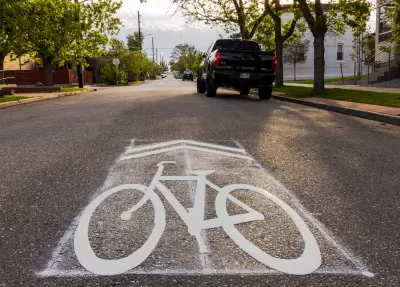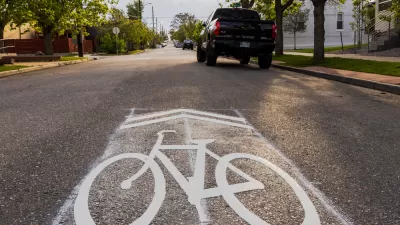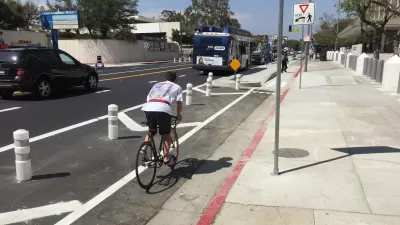Originally designed as a low-cost way to encourage safer road sharing between bikes and cars, the sharrow has become a symbol of the lack of commitment to protected bike infrastructure in many cities.

Many cyclists hate them. Most drivers don’t see or understand them. So why are sharrows—the painted symbols also known as lane-share markers—so popular with local governments and departments of transportation?
As Kyle Harris points out in a piece for Denverite, the answer is simple: cost. “Thrifty urban planners, disinterested in building significant bike infrastructure, have embraced them. Sharrows give city officials a cheap way to say they’re doing something for cyclists’ safety — even if it’s undermining it.” Indeed, “According to a 2016 University of Colorado, Denver study of bike infrastructure conducted over ten years and on 2,000 blocks in Chicago, sharrows might actually be more dangerous than no infrastructure at all.”
Harris outlines the history of the sharrow symbol, which was created by now-retired Denver bicycle traffic engineer James Mackay in the early 1990s, when the city resisted any efforts to make changes or invest in bike infrastructure. Mackay developed the symbol as an inexpensive way to encourage drivers and cyclists to share the road, but acknowledges that “Given funding and political will, Mackay knows Denver could have done more, such as cities like Copenhagen and Utrecht, to actively discourage driving and encourage biking.”
FULL STORY: Nobody really understands or likes this street symbol, so how’d it get made?

Planetizen Federal Action Tracker
A weekly monitor of how Trump’s orders and actions are impacting planners and planning in America.

San Francisco's School District Spent $105M To Build Affordable Housing for Teachers — And That's Just the Beginning
SFUSD joins a growing list of school districts using their land holdings to address housing affordability challenges faced by their own employees.

The Tiny, Adorable $7,000 Car Turning Japan Onto EVs
The single seat Mibot charges from a regular plug as quickly as an iPad, and is about half the price of an average EV.

Seattle's Plan for Adopting Driverless Cars
Equity, safety, accessibility and affordability are front of mind as the city prepares for robotaxis and other autonomous vehicles.

As Trump Phases Out FEMA, Is It Time to Flee the Floodplains?
With less federal funding available for disaster relief efforts, the need to relocate at-risk communities is more urgent than ever.

With Protected Lanes, 460% More People Commute by Bike
For those needing more ammo, more data proving what we already knew is here.
Urban Design for Planners 1: Software Tools
This six-course series explores essential urban design concepts using open source software and equips planners with the tools they need to participate fully in the urban design process.
Planning for Universal Design
Learn the tools for implementing Universal Design in planning regulations.
Smith Gee Studio
City of Charlotte
City of Camden Redevelopment Agency
City of Astoria
Transportation Research & Education Center (TREC) at Portland State University
US High Speed Rail Association
City of Camden Redevelopment Agency
Municipality of Princeton (NJ)





























